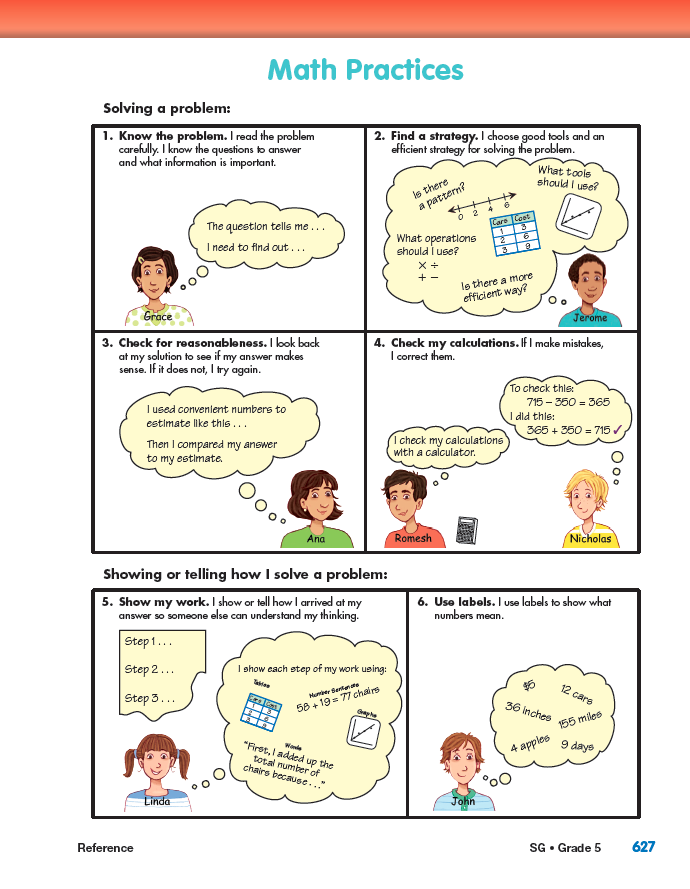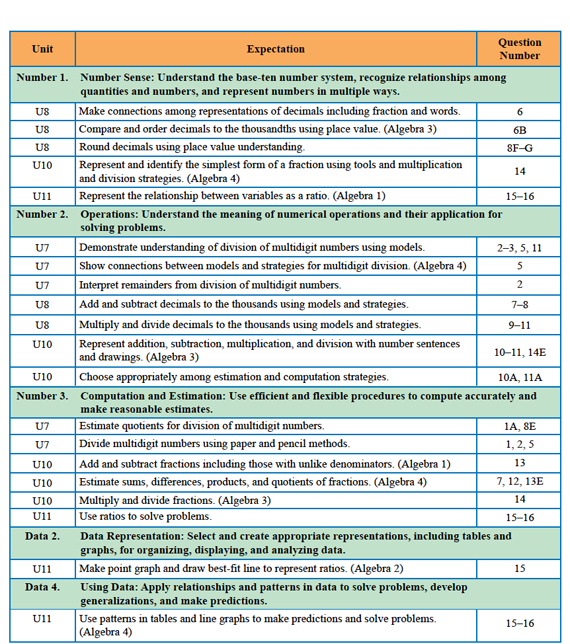Review Math Practices. Direct students to the Math Practices page in the Student Guide Reference section. Tell students they are going to take a test on the skills and concepts they have learned in the last five units. Help students think about the Math Practices Expectations they will focus on during this assessment.
- Look at the Math Practices page. What can you do to make sure you understand what you are being asked to do in a problem? (Possible response: You need to read each part of the problem carefully so you know what you are being asked to do. You also need to think about the meaning of each number in the problem.)
- What are some tools that we use in math class that might help you as you are working on the test? (Possible response: You can use any tools that we use during class, like rulers, fraction circle pieces, and calculators. You can also use any of the pages in the Student Guide Reference section.)
- As you are working, what are some strategies you can use to make sure your answers make sense and that your calculations are correct? (Possible response: You can use estimation to see if your answer is reasonable. You can check your calculations using another strategy. For example, you can check your division by using multiplication or, you can solve the problem in more than one way.
- Some problems will ask you to explain your thinking. What should you remember to include that shows someone else what you are thinking? (Possible response: You can use words, pictures, and number sentences to show how you solve a problem. You can also use data tables, graphs, or charts. You should also label your numbers to show what they mean.)
Complete the Assessment. Students take the test individually. The assessment is designed to be completed in one or two class sessions; however, you may choose to give students more time to complete it.
Ask students to follow the directions for each item. Some ask them to tell how they solved the problem. Encourage students to give full explanations for the problem-solving process used.
In Part 1, students solve division problems. Students use partial-quotients and one other method to solve problems in Question 1A–C. In Question 1D, students use estimation to check the reasonableness of their work and in Question 1E, they use multiplication to check their calculations. For Questions 2–3, students solve multistep problems involving division with remainders. Students use estimation strategies for Question 4A–B. In Question 5, students connect the partial quotients method to the rectangle model. Students should be encouraged to use tools they have worked with in class such as the strategies menus and Math Practices page in the Student Guide Reference section. The items in this section are designed to assess students' understanding and use of strategies for operations involving multidigit numbers. Therefore, students should not use a calculator on this section.
In Part 2, problems cover a wide variety of skills and concepts. If you have skipped lessons, you may choose not to assign certain questions. Questions 6–11 involve concepts related to decimals including comparing and ordering decimals, rounding, addition, subtraction, multiplication and division.
Students use their understanding of fractions to complete Questions 12–14. They use a data table, graph, and their understanding of ratios to solve problems in Questions 15–16.

Use the End-of-Year Test Assessment Masters to assess concepts and skills studied in Units 7–11. As with all such cumulative assessments, it is only one indication of a student's progress and should be read in conjunction with other data such as observations, written work on extended response questions, and documentation of student progress on Expectations.
The overall score on the End-of-Year Test can be used to provide a broad-brush view of a student's progress. However, the test is better utilized to give information about specific areas of interest and concern. The questions on the test can be matched with specific Key Ideas and Expectations within content strands. See Figure 1. Isolating the answers to specific questions can contribute to a more robust picture of student progress.
Use the Feedback Box to assess students' abilities to read and understand the problem [MPE1]; choose good tools and strategies [MPE2]; check for reasonableness [MPE3]; check my calculations and make corrections if needed [MPE4]; communicate solution strategies [MPE5]; and label answers [MPE6].














